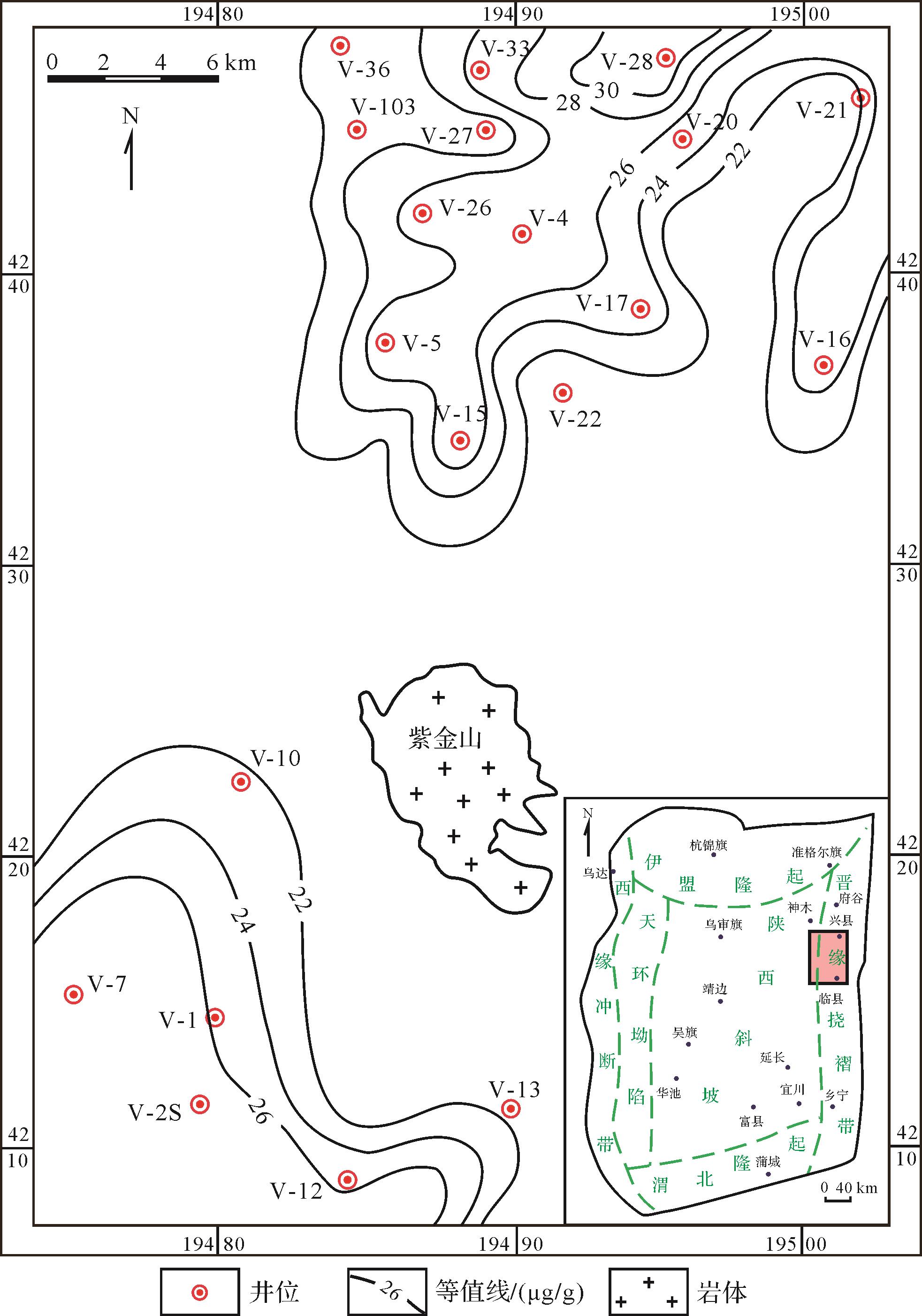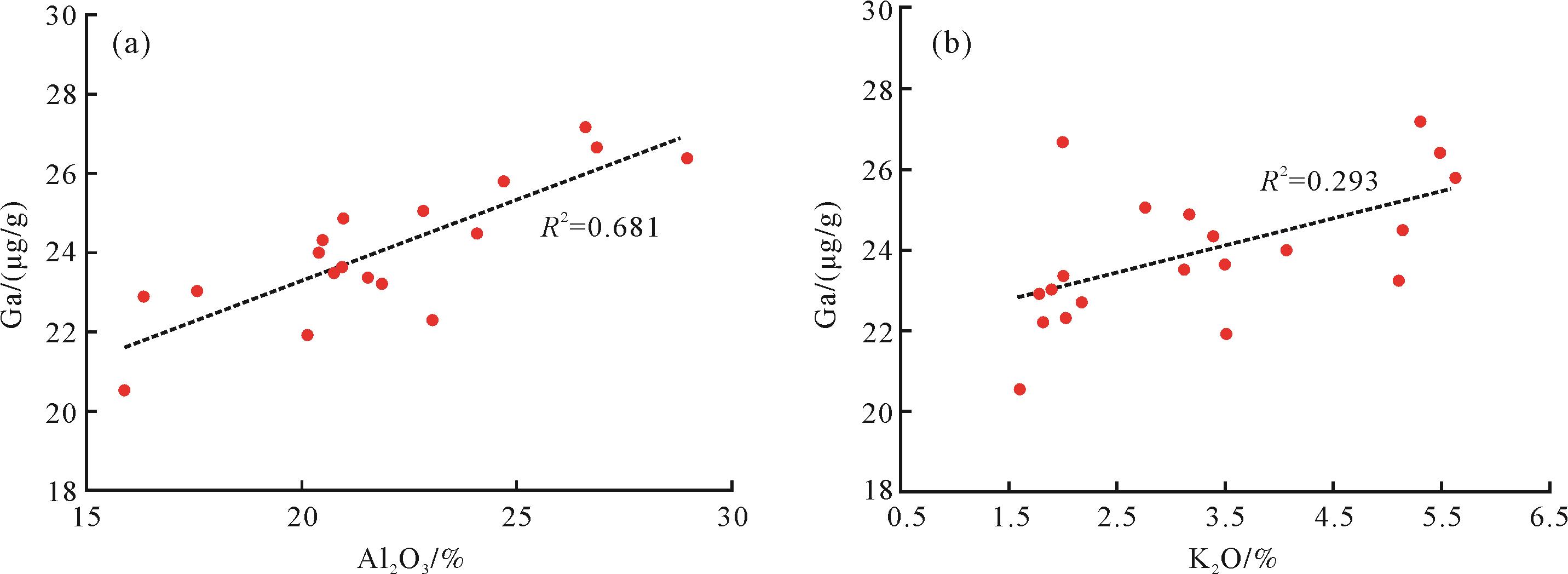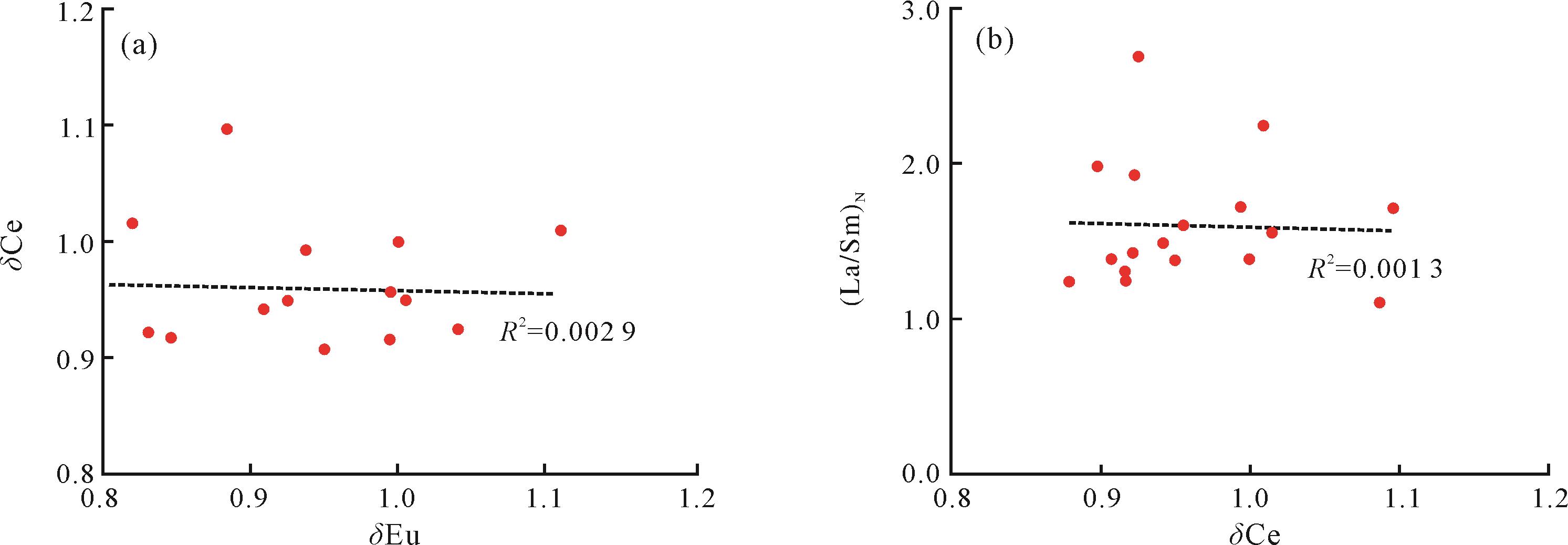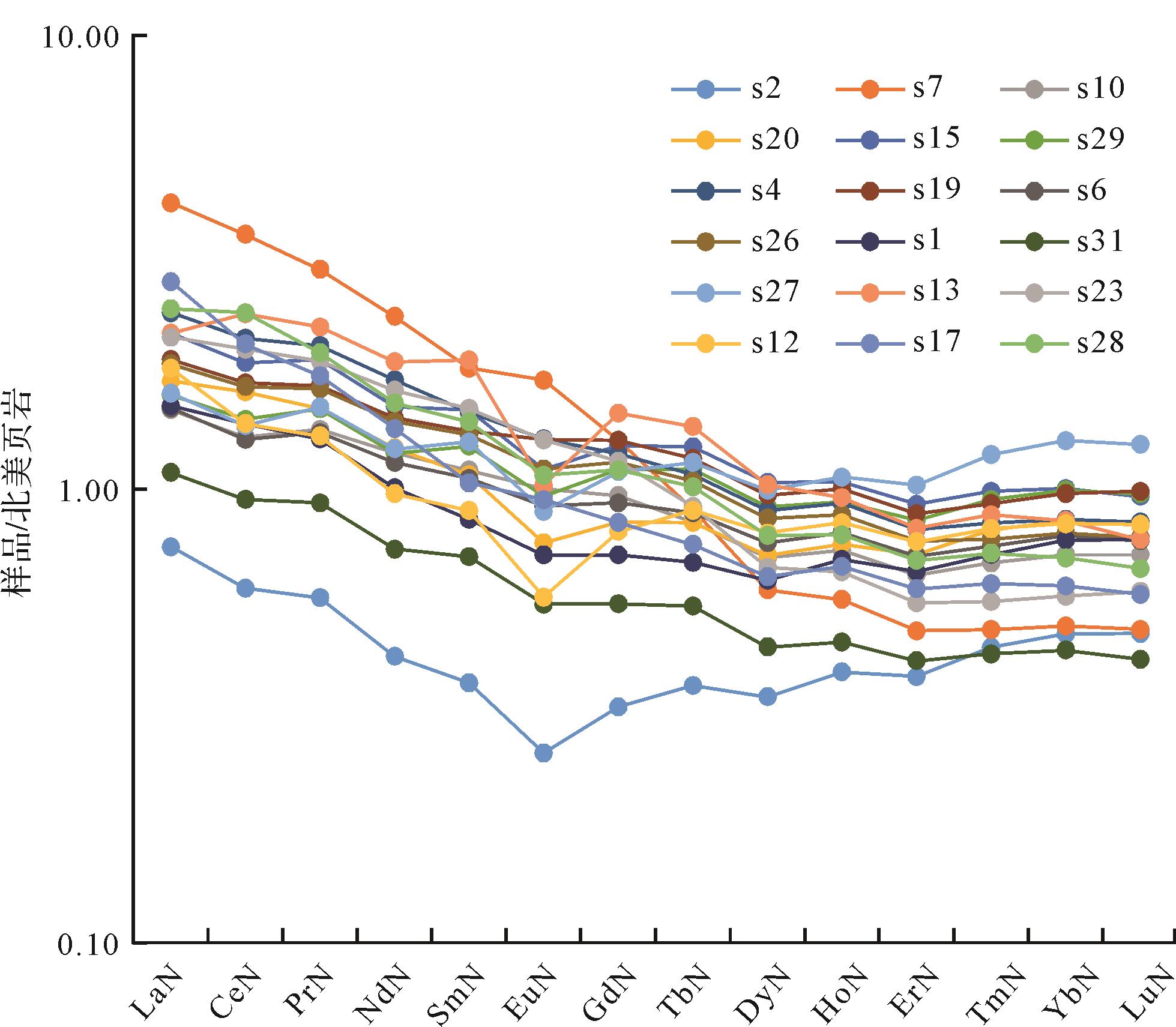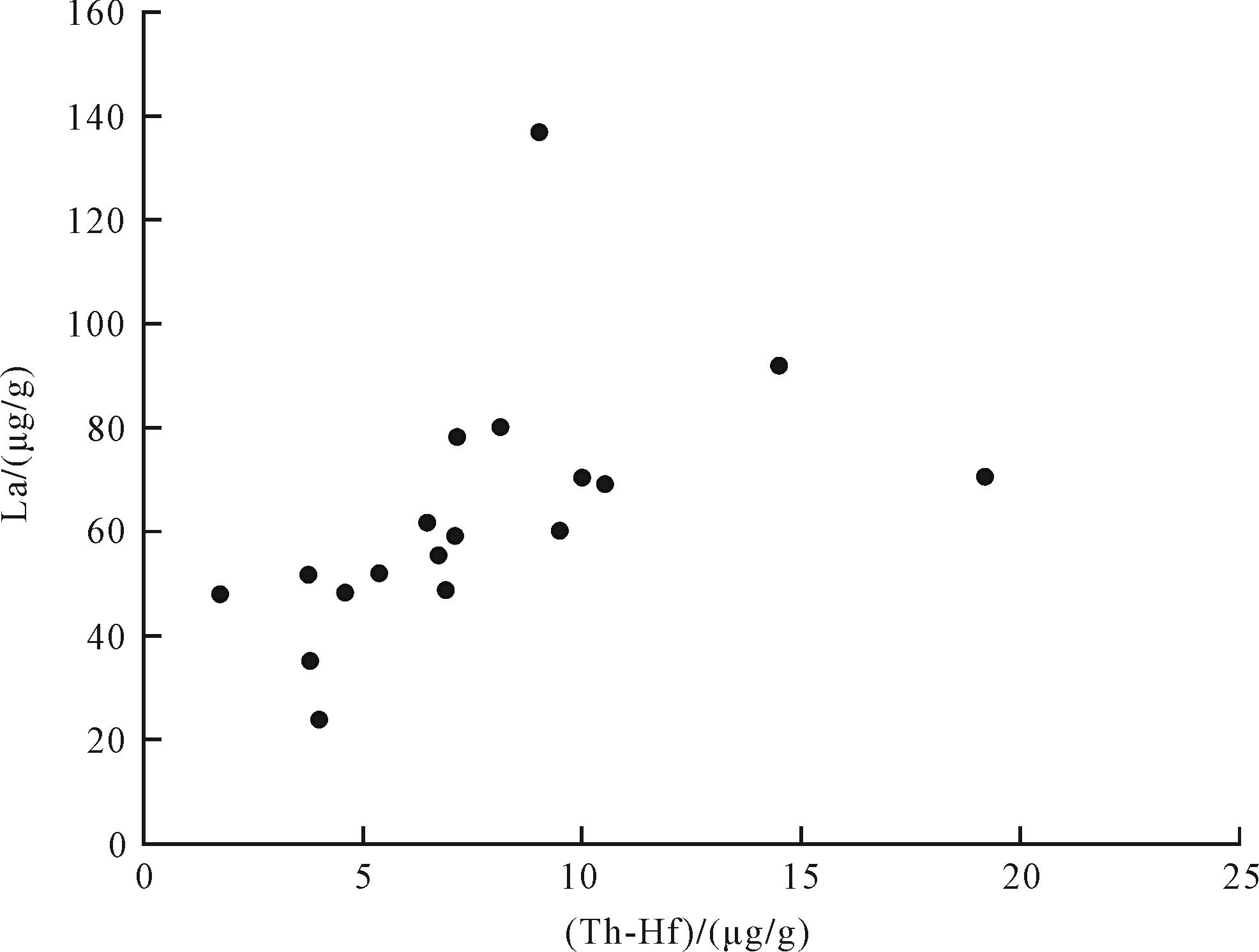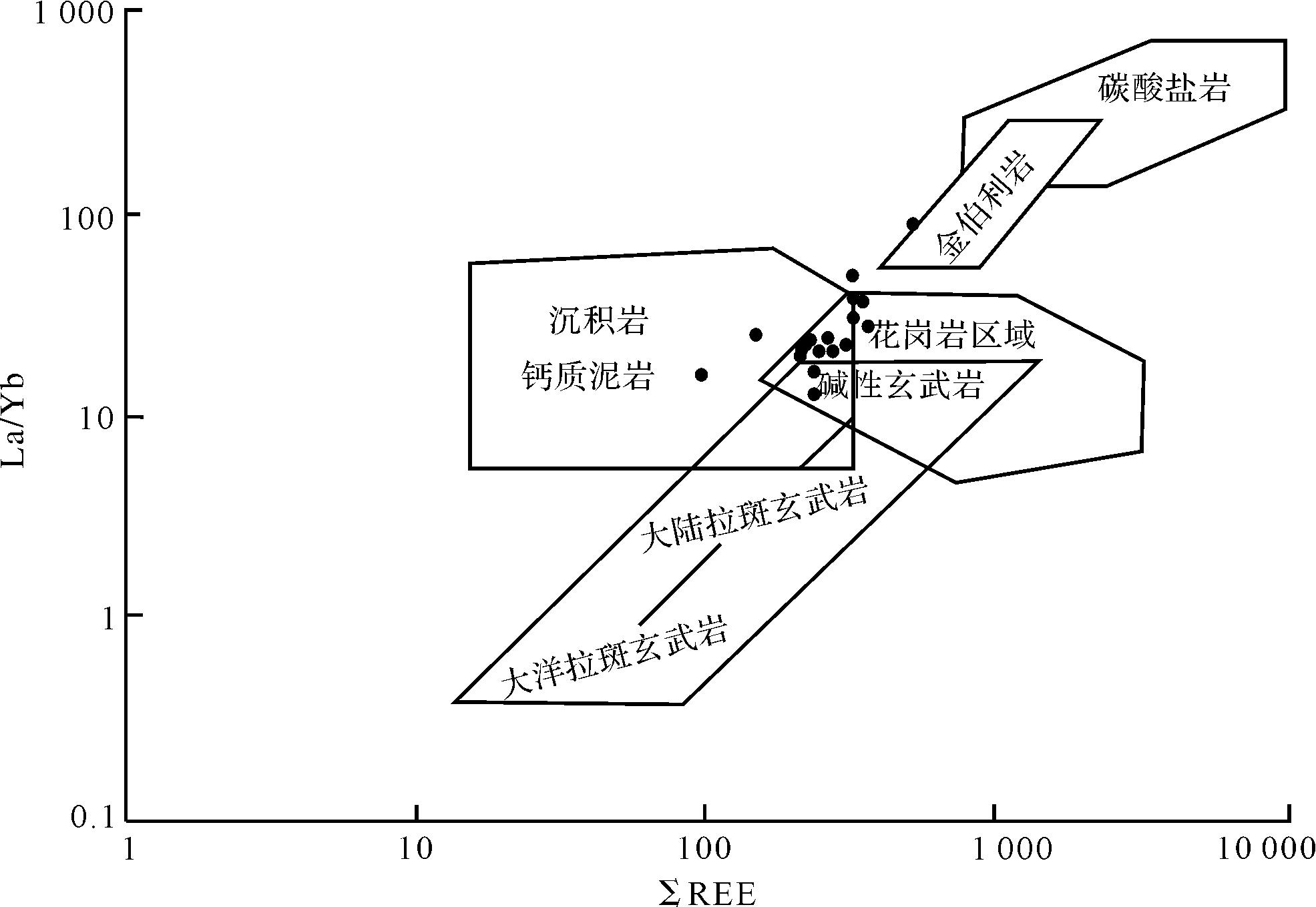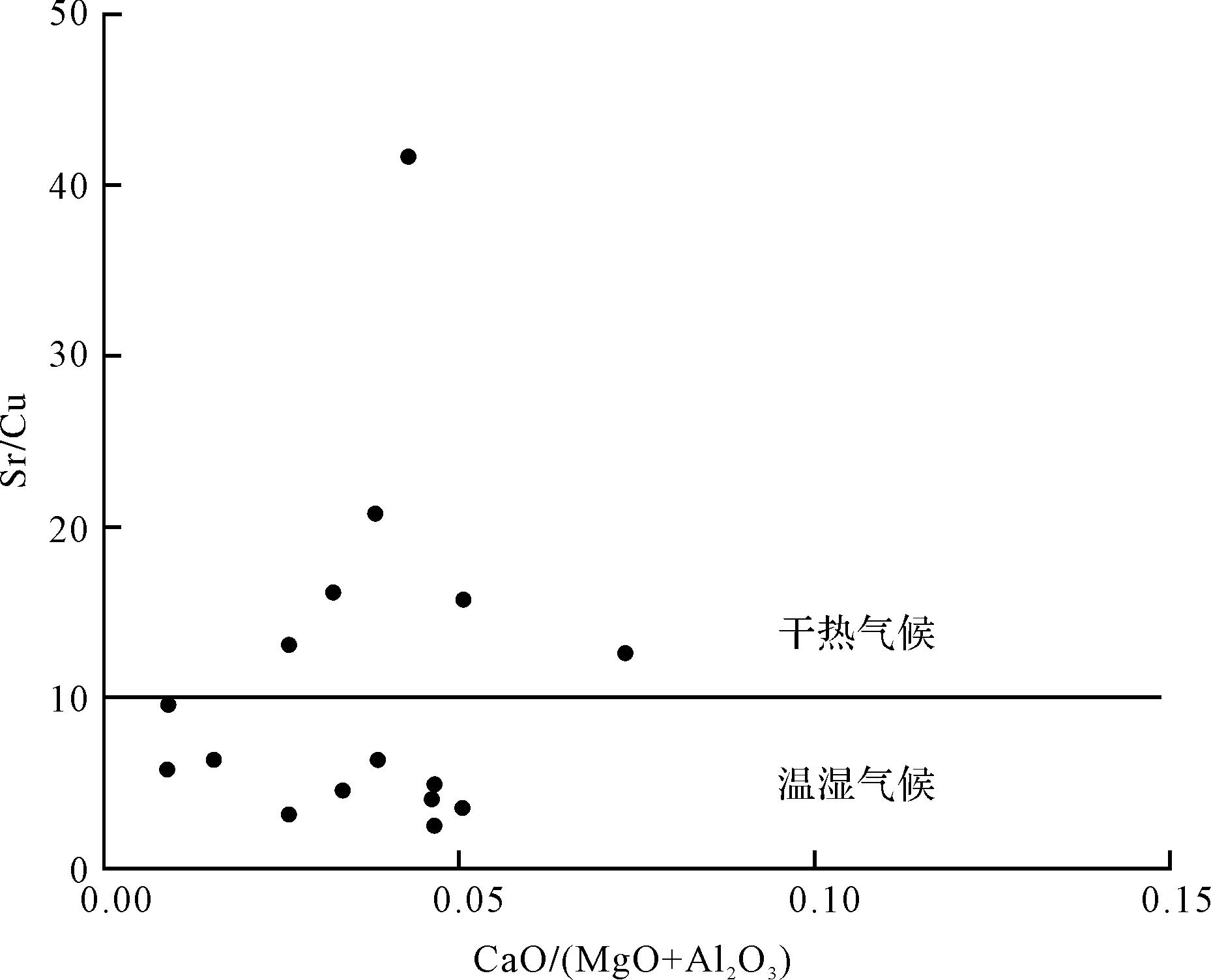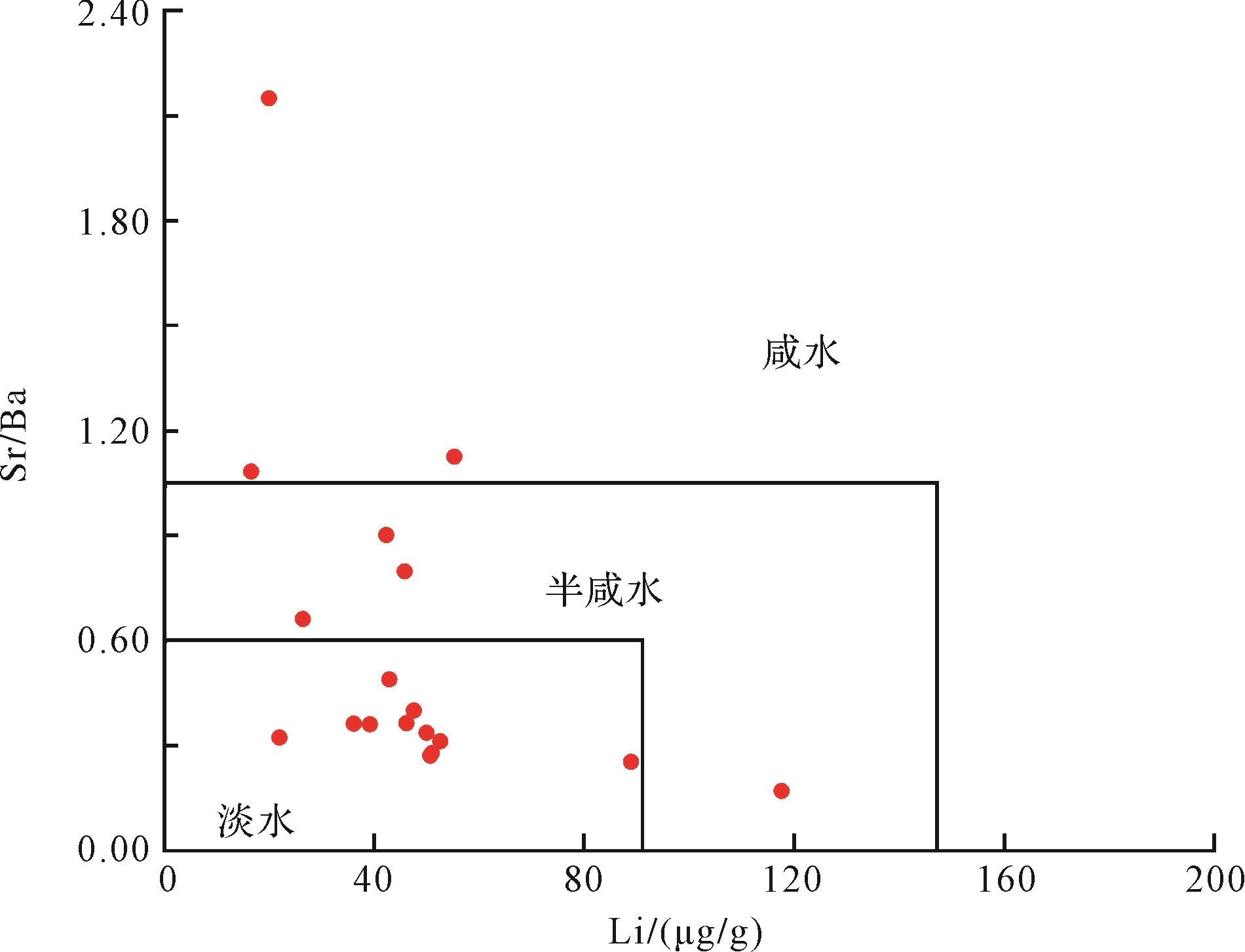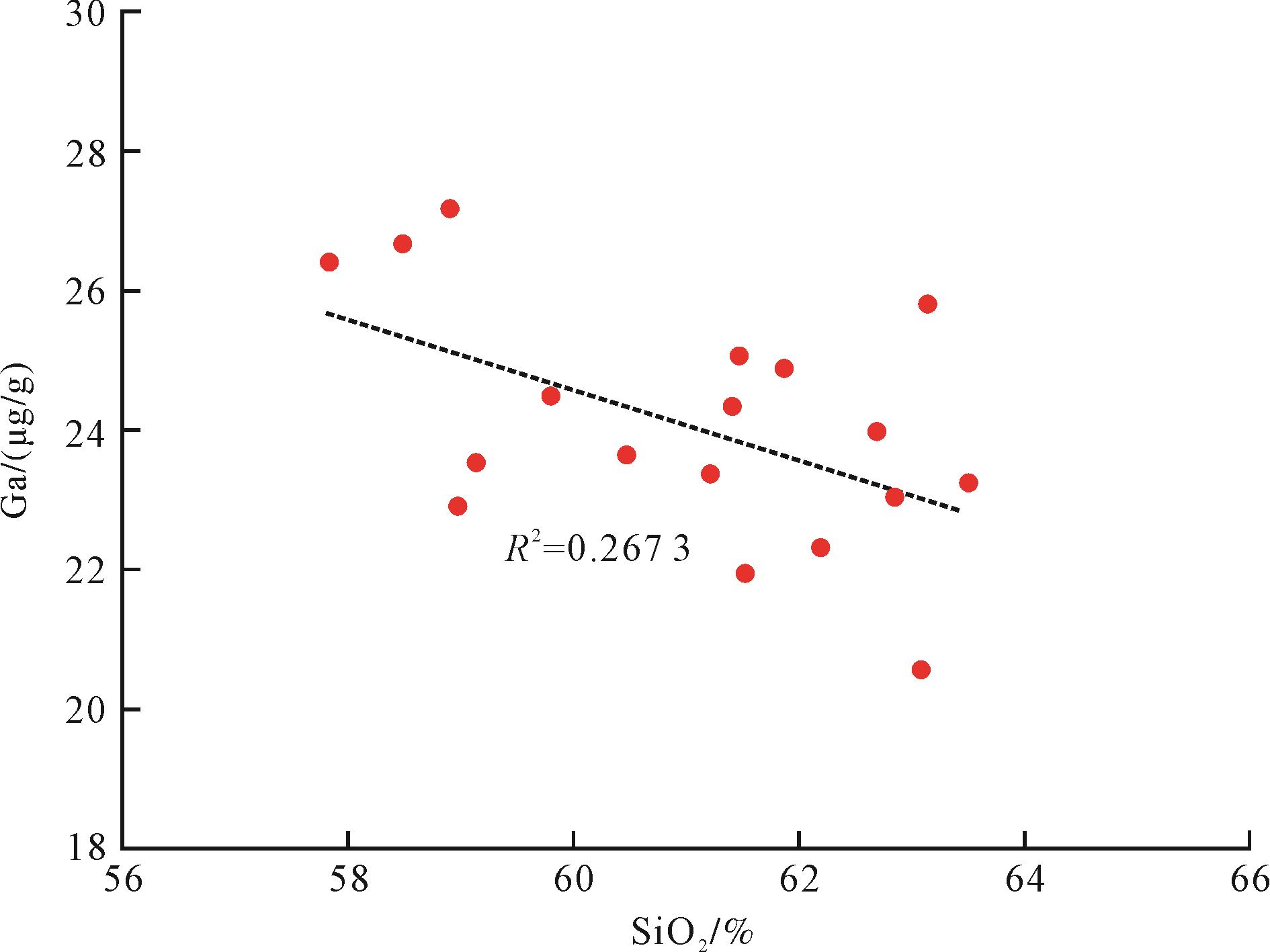HTML
-
战略性金属矿产是国民经济持续发展和国防安全的基础[1]。煤系物质组成和形成过程复杂,在其特定的地质作用下,可以富集战略性金属元素。煤系战略性金属矿产研究已成为世界产煤国家的前沿课题[2]。国内许多学者在我国广西[3]、贵州[4]、新疆[5]、山西[6⁃7]和内蒙古[8⁃12]等多个地区开展了煤中镓的富集机理研究,获得了重要成果[13⁃15]。煤系泥页岩,作为与煤共伴生的沉积岩系,与煤具有极其相似的沉积和成岩环境。然而,镓的成矿潜力和地质主控因素研究中,针对煤系泥页岩的成果较少,有待进一步探索研究。鄂尔多斯盆地煤炭资源丰富,储量占全国的33.6%,与石油、天然气和稀有金属等矿产资源相互伴生和叠加,是一个综合性资源盆地[16]。前人针对鄂尔多斯盆地上古生界泥页岩中稀土和微量元素特征开展基础研究工作,探讨其在沉积环境与物源分析等方面的指示意义[17⁃19]。然而由于关注点不同,前人在鄂尔多斯盆地东缘临兴地区开展的研究工作聚焦于聚煤规律和煤系气资源评价等方面[20⁃21],对煤系泥页岩中镓的富集成因尚缺乏系统研究。临兴地区太原组下段煤系泥页岩明显富集镓元素。笔者通过研究区典型钻井中煤系暗色泥页岩的主量、微量及稀土元素地球化学特征的研究,系统地分析煤系泥页岩的物源、沉积环境和成岩阶段特征,厘清煤系特殊的沉积环境、成岩环境与泥页岩中镓元素富集的时间和空间匹配关系,探讨泥页岩中镓富集特征和成因,为煤系战略性金属矿产的赋存状态、分布规律与机理研究工作提供参考。
-
鄂尔多斯盆地总面积约为25×104 km2,是我国第二大沉积盆地,由6个次一级构造单元组成,分别是:西缘冲断带、天环坳陷、伊盟隆起、陕北斜坡、渭北隆起、晋西挠褶带[22]。临兴地区位于晋西挠褶带中北部(图1),受构造—沉积背景的控制,经历了快速、不连续的海侵过程以及缓慢、相对稳定持续的海退过程。
临兴地区隶属于华北地层区,太原组是华北地层区主要的含煤地层之一,厚34~77 m,与本溪组整合接触,是8#、9#煤层之顶到“北岔沟砂岩”之底的一套煤系[23⁃24]。临兴地区太原组下段煤系泥页岩总厚度为17~57 m,平均约为30 m。岩性包括黑色炭质泥页岩、灰—灰黑色粉砂质泥岩、灰黑色泥岩等,泥页岩岩心中可见植物叶片化石,发育水平层理和波状层理。总体特征为单层厚度相对较薄而层数较多,在垂向上与砂岩及煤层相互叠置(图1)。
-
泥页岩样品来自鄂尔多斯盆地东缘临兴地区13口钻井的岩心样,其中有10口钻井各采集1件样品,有2口钻井各采集3件样品,有1口钻井采集2件样品,共计18件,岩性均为暗色泥页岩。样品钻井位置主要分布于区内紫金山岩体的北侧,部分样品钻井位置位于紫金山岩体的西南侧。采样层位均属于太原组下段,即对应于图1中岩性柱状图里的太原组太2段。对泥页岩样品开展了有机碳含量、主量元素、微量元素和稀土元素测试分析。有机碳含量、微量元素和稀土元素测试分析在中国科学院油气资源研究重点实验室完成,其中有机碳含量分析测试在CS-344型碳硫分析仪上进行。微量元素和稀土元素测试分析在ELANDRC-e型电感耦合等离子体质谱仪(ICP-MS)上进行。主量元素测试分析在甘肃省西部矿产资源重点实验室的Agilent720Axial型电感耦合等离子体原子发射光谱仪(ICP-OES)上进行。
-
研究区太原组下段煤系泥页岩的有机碳变化范围较大(表1),碳含量介于0.41%~4.93%,平均为2.32%。样品硫含量介于0.02%~1.68%,平均为0.42%,且分布具有明显的两段性:低硫段0.02%~0.41%和高硫段1.21%~1.68%。研究区大部分样品(15个)属于低硫区域(硫含量0.02%~0.41%),只有3个样品硫含量较高(1.21%~1.68%)。
样品编号 TOC S P2O5 Fe2O3 SiO2 Al2O3 MgO CaO Na2O K2O CaO/(MgO+Al2O3) V1-1 0.41 0.40 0.13 1.72 63.13 24.71 0.14 0.10 0.21 5.63 0.03 V1-2 1.12 0.37 0.16 5.41 60.48 20.93 0.86 0.77 0.30 3.50 0.04 V1-3 1.48 1.68 0.13 13.28 58.98 16.34 0.35 0.42 0.24 1.78 0.07 V4-1 2.42 0.32 0.14 1.97 58.49 26.87 0.23 0.20 0.13 2.00 0.03 V5-3 3.61 0.12 0.12 1.61 62.69 20.42 0.39 0.37 0.20 4.07 0.05 V10-1 3.05 0.07 0.06 0.99 61.21 21.54 0.17 0.14 0.13 2.00 0.04 V16-2 1.85 1.21 0.09 5.07 61.47 22.83 0.31 0.11 0.28 2.76 0.02 V17-1 1.55 1.20 0.11 9.07 61.86 20.96 0.83 0.88 0.36 3.17 0.05 V20-1 4.00 0.29 0.05 2.60 59.80 24.09 0.42 0.47 0.53 5.14 0.05 V20-2 4.93 0.19 0.12 1.55 61.41 20.49 0.33 0.34 0.16 3.39 0.05 V20-22 1.81 0.02 0.03 0.61 62.84 17.57 0.24 0.11 0.24 1.89 0.03 V21-1 0.61 0.39 0.17 1.70 61.53 20.14 0.20 0.34 0.11 3.52 0.08 V22-1 1.82 0.31 0.06 2.00 63.08 15.90 0.29 0.12 0.18 1.60 0.03 V27-1 1.03 0.20 0.16 2.41 63.48 21.87 0.46 0.39 0.29 5.10 0.04 V28-2 4.07 0.05 0.04 0.86 57.84 28.96 0.13 0.11 0.18 5.48 0.01 V33-1 2.60 0.38 0.10 3.53 58.90 26.59 0.79 0.19 0.15 5.30 0.01 V36-1 2.39 0.35 0.13 6.49 59.14 20.77 0.82 0.79 0.21 3.12 0.05 V36-11 3.08 0.03 0.04 1.17 62.19 23.05 0.18 0.14 0.13 2.02 0.03
-
主量元素分析显示研究区太原组下段煤系泥页岩的主要成分为SiO2、Al2O3、Fe2O3和K2O,4种成分的总含量高达82.9%~95.2%(表1)。其中,SiO2含量最高,含量介于57.8%~63.5%,平均为61.0%;Al2O3含量次之,含量介于15.9%~29.0%,平均为22.1%;Fe2O3的非均质性强,含量介于0.6%~10.3%,平均为3.5%;K2O的含量介于1.6%~5.6%,平均为3.4%。除了这4种成分,太原组下段煤系泥页岩中含有少量的Na2O(含量介于0.1%~0.5%,平均为0.2%)、MgO(含量介于0.1%~0.9%,平均为0.4%)、CaO(含量介于0.1%~0.8%,平均为0.3%)、TiO2(含量介于0.7%~1.8%,平均为1.2%)和P2O5(含量介于0.03%~0.16%,平均为0.10%)。
-
微量元素分析结果显示(表2),研究区太原组下段煤系泥页岩的Li、Co和Cu元素含量波动最大,其含量最大值和最小值相差40倍以上;其次为Ni、Zn、Mo和Cd,最大值与最小值相差10~40倍;再次是Cs和Hf,最大值与最小值相差5~10倍;Be、V、Cr、Ga、Ge、Rb、Sr、Zr、Nb、Sn、Ba、Tl、W、Ta、Pb、Bi和U含量较稳定,最大值与最小值相差1~5倍。
样品编号 Li V Cr Co Ni Ga Sr Zr Sr/Ba δU V/(V+Ni) Sr/Cu V/Cr Ni/Co Th-Hf Th/U V1-1 45.81 67.45 44.21 0.85 5.45 25.80 153.06 184.92 0.79 0.86 0.93 85.22 1.53 6.43 3.97 4.46 V1-2 16.62 108.08 57.53 17.99 22.44 23.62 512.87 369.30 1.08 0.81 0.83 41.62 1.88 1.25 8.99 4.91 V1-3 26.33 95.35 55.86 22.00 30.01 22.89 258.38 328.59 0.66 0.90 0.76 12.51 1.71 1.36 1.75 4.10 V4-1 52.50 147.33 79.87 16.79 62.84 26.66 169.32 231.52 0.32 0.79 0.70 16.12 1.84 3.74 6.69 5.11 V5-3 49.72 116.79 53.77 18.54 33.52 23.98 154.35 183.80 0.34 0.81 0.78 4.92 2.17 1.81 9.98 4.94 V10-1 55.18 127.33 66.01 11.86 45.80 23.36 233.89 257.36 1.13 0.89 0.74 20.78 1.93 3.86 3.72 4.19 V16-2 47.38 108.73 60.85 21.57 31.39 25.06 153.21 276.82 0.40 0.85 0.78 6.31 1.79 1.46 7.12 4.52 V17-1 39.51 138.82 73.87 28.32 38.68 24.86 190.76 269.31 0.36 0.85 0.78 15.75 1.88 1.37 6.46 4.47 V20-1 51.17 94.47 49.45 16.30 33.75 24.48 99.35 173.53 0.28 0.89 0.74 2.51 1.91 2.07 4.56 4.16 V20-2 50.53 90.89 43.68 13.90 29.05 24.33 101.46 194.35 0.27 0.85 0.76 3.51 2.08 2.09 9.46 4.52 V20-22 42.41 152.52 82.98 19.38 64.02 23.03 175.30 172.67 0.49 0.86 0.70 13.13 1.84 3.30 6.87 4.39 V21-1 20.15 82.28 33.66 6.73 25.01 21.92 807.03 78.34 2.14 1.06 0.77 89.11 2.44 3.72 3.77 2.96 V22-1 88.52 100.92 67.41 12.22 23.69 20.55 82.17 290.71 0.26 0.91 0.81 3.15 1.50 1.94 5.35 3.96 V27-1 21.85 72.64 39.79 3.81 7.91 23.23 132.23 240.58 0.32 0.84 0.90 6.30 1.83 2.08 19.19 4.65 V28-2 41.88 59.64 34.44 5.82 16.31 26.40 201.45 95.38 0.90 0.88 0.79 9.44 1.73 2.80 10.48 4.26 V33-1 117.16 97.57 66.60 8.64 28.37 27.16 63.28 457.44 0.17 0.82 0.77 5.82 1.46 3.28 7.11 4.83 V36-1 36.12 128.93 54.11 9.27 26.46 23.51 139.72 168.96 0.36 0.86 0.83 4.14 2.38 2.85 14.49 4.38 V36-11 45.88 132.30 76.31 11.65 18.28 22.31 122.40 367.88 0.37 0.92 0.88 4.51 1.73 1.57 8.12 3.88 将研究区太原组下段煤系泥页岩的微量元素与平均页岩[25]进行对比,得到研究区太原组下段煤系泥页岩的微量元素富集特征。结果显示,研究区太原组下段煤系泥页岩中Ga、Hf、Bi、Zr、Pb和Th富集;Cr、Co、Cu、Zn、Rb、Sr、Mo、Sn、Ba、Ta、Ni和Cd亏损明显。其他元素接近平均页岩元素丰度。
-
研究区太原组下段煤系泥页岩中的稀土总量(ΣREE)分布在97.10~535.27 μg/g之间,平均值为277.42 μg/g,是大陆上地壳[26]稀土平均含量(ΣREE=146.4 μg/g)的1.9倍,是平均页岩[25]的1.4倍,表现出REE富集特征。轻重稀土元素之比LREE/HREE(L/H)为9.56~33.68,平均值为16.09,比上地壳L/H比值(9.5)大,LaN/LuN为1.80~3.27,均大于1。δCe介于0.88~1.13,平均值为0.98;δEu介于0.62~1.11,平均值为0.89(表3)。
样品编号 La Ce Pr Nd Sm Eu Gd Tb Dy Ho Er Tm Yb Lu Y V1-1 23.89 44.20 4.55 14.12 2.21 0.35 1.79 0.31 2.02 0.41 1.31 0.22 1.49 0.23 10.71 V1-2 136.91 266.37 24.13 79.32 10.91 2.20 6.91 0.77 3.48 0.59 1.66 0.25 1.55 0.24 13.86 V1-3 47.89 95.20 10.70 39.69 6.50 1.32 5.23 0.72 4.10 0.76 2.20 0.34 2.22 0.34 19.20 V4-1 55.40 119.62 11.90 40.71 6.34 1.00 4.56 0.72 4.15 0.79 2.44 0.41 2.64 0.40 19.25 V5-3 70.62 138.86 15.25 50.16 8.82 1.46 6.74 1.05 6.00 1.08 3.15 0.49 3.11 0.46 26.37 V10-1 51.54 104.13 11.87 39.54 7.34 1.28 5.97 0.94 5.30 0.98 2.91 0.47 3.09 0.47 24.21 V16-2 78.46 157.20 16.37 57.44 8.73 1.70 6.46 0.91 5.20 0.97 2.77 0.42 2.66 0.41 24.37 V17-1 61.82 125.26 13.35 47.38 7.93 1.70 6.92 0.99 5.63 1.04 3.00 0.46 3.03 0.47 27.27 V20-1 48.36 93.99 10.52 37.76 6.23 1.21 5.04 0.75 4.42 0.84 2.42 0.37 2.45 0.37 20.97 V20-2 60.40 122.90 13.16 46.54 7.78 1.46 6.19 0.89 5.01 0.91 2.61 0.39 2.48 0.38 23.80 V20-22 48.88 101.78 10.19 33.21 5.07 0.95 3.87 0.59 3.65 0.73 2.24 0.36 2.40 0.37 18.75 V21-1 34.83 69.26 7.37 24.34 4.18 0.74 3.02 0.47 2.60 0.48 1.42 0.22 1.37 0.20 12.18 V22-1 52.10 100.82 11.98 40.49 7.50 1.18 5.91 0.97 5.77 1.11 3.47 0.60 3.97 0.60 25.34 V27-1 70.62 177.94 18.01 63.02 11.37 1.35 7.95 1.17 5.94 1.00 2.79 0.44 2.64 0.37 22.30 V28-2 69.25 148.63 15.13 54.54 8.89 1.70 6.23 0.78 3.90 0.68 1.91 0.28 1.80 0.29 17.11 V33-1 59.10 101.94 10.36 32.27 5.29 0.76 4.36 0.76 4.64 0.88 2.61 0.41 2.60 0.40 21.69 V36-1 91.87 152.60 14.05 44.91 6.10 1.25 4.56 0.64 3.72 0.70 2.05 0.31 1.90 0.28 16.38 V36-11 79.99 178.95 15.80 51.17 8.31 1.42 5.95 0.86 4.59 0.83 2.37 0.36 2.19 0.32 19.21
-
研究区太原组下段煤系泥页岩中微量元素测试结果显示(表2),泥页岩中镓元素(Ga)含量介于20.55~30.35 μg/g,平均值为24.7 μg/g,大于上地壳(17.5 μg/g[26])和平均页岩(19 μg/g[25])中镓的含量,与邻近区域的准格尔煤中镓含量相近,具有镓富集特点,略低于镓工业边界品位(30 μg/g)[2]。
富集系数可以反映元素的富集程度[27]。本文将富集系数(K)定义为研究区泥页岩中镓元素含量值与上地壳中镓元素平均丰度值的比值。富集系数按大小可将元素分成6类:极富集(K≥2),较富集(1.5≤K<2),弱富集(1.0≤K<1.5),弱亏损(0.5≤K<1),较亏损(0.25≤K<0.5),弱富集(0≤K<0.25)[27]。本文研究样品镓元素的富集系数(K)分布在1.2~1.6,平均富集系数(K)为1.4,总体上属于弱富集。
太原组下段煤系泥页岩中镓元素在研究区内平面分布呈一定规律性(图2),具体表现为:紫金山岩体以北的研究区,随着靠近紫金山岩体,镓含量具有由北向南逐渐降低的趋势;紫金山岩体西南部的研究区,沿着靠近紫金山岩体的方向,镓含量也具有降低的趋势。这是因为镓的熔点较低,紫金山岩体的侵位导致镓在高温作用下发生了由高温区向低温区的迁移作用。由于紫金山岩体规模较小,岩体的温度效应对镓含量分布的影响只涉及了岩体周边较小的范围。
研究区太原组下段煤系泥页岩的镓含量与邻区准格尔煤中镓含量相近[8],而准格尔煤中镓具有较好成矿前景已经取得共识[8⁃9,11⁃12]。临兴地区太原组下段煤系泥页岩总厚度大(平均约为30 m)、分布广,镓含量较高的煤系泥页岩总体发育规模大,其中赋含的镓元素资源量规模也大,具有较好的潜在成矿前景。
-
镓元素是亲石元素,分散性强,经常以类质同象替代的形式赋存在矿物中。煤中镓主要以类质同象取代铝的形式存在含铝元素的高岭石、勃姆石、长石等矿物中[9,28]。通过XRD、扫描电镜等实验,可以明确识别出研究区太原组下段煤系泥页岩中发育较高含量的高岭石、长石。研究样品中镓含量与Al2O3存在较好的正相关性(图3a),相关系数为0.681,这指示富铝的高岭石等黏土矿物是镓元素的主要赋存矿物。研究样品中镓元素与K2O存在正相关性(图3b),相关的系数为0.293。煤系泥页岩中的钾元素主要由碱性长石和伊利石等含钾的黏土矿物提供,镓元素与K2O存在正相关性则说明了泥页岩中的碱性长石和伊利石等黏土矿物也是镓元素的重要赋存矿物。

Figure 3. Correlation of gallium content in coal⁃measure shale, lower Taiyuan Formation, Linxing area with (a) Al2O3, (b) K2O
由上述可知,泥页岩中镓元素的富集与泥页岩中矿物成分关系密切。X射线衍射分析结果显示[29],研究区太原组下段煤系泥页岩的黏土矿物平均含量为52%,石英平均含量为38%,长石平均含量为7%,碳酸盐矿物平均含量为5%。黏土矿物主要由高岭石、伊蒙混层、伊利石以及绿泥石组成,其中高岭石相对含量为21%~58%,平均含量为35.25%[29]。前文提到,黏土矿物中的高岭石是煤系泥页岩中镓元素最主要的赋存矿物之一,研究区太原组下段煤系泥页岩中具有较高含量的高岭石,这为镓元素的富集提供了重要的物质基础。
-
由于煤系中的镓元素主要赋存在高岭石、勃姆石等矿物中。通过重矿物分析等方法,发现临兴地区太原组的物源为陆源输入,来自北部阴山古陆剥蚀区[30]。临兴地区太原组煤系泥页岩有机质类型以III型为主[31],也反映了陆源有机质输入为主。除陆源供给外,火山碎屑、海底热液、海水及海洋生物等也是沉积物的重要来源。稀土元素的化学性质与分异行为均比较特殊,从源岩到沉积物,分布模式变化并不明显,并且稀土及部分微量元素的比值在沉积和变质作用过程中具有较好的抗迁移性,因而是较好的物源指示剂[32]。研究区太原组下段煤系泥页岩样品中,δCe与δEu、δCe与(La/Sm)N均没有相关性(图4a,b),证明成岩作用对稀土元素的分布影响不明显。海底高温热液具有强烈的Eu正异常特征[33]。本文研究样品稀土元素分布特征显示,有10件样品呈Eu负异常、8件样品呈正异常特征,与海底高温热液强烈Eu正异常特征存在显著差异,据此判断研究样品中的稀土元素的物源并非热液成因来源。海水的稀土元素分布特征一般为显著的负Ce异常、HREE富集、高Y/Ho比值和正La异常[34]。而研究泥页岩样品的稀土元素分布表现为LREE富集、正Ce异常、较低Y/Ho比值、正La异常,与海水稀土元素分布特征明显不同,据此判断研究样品中的稀土元素的物源并非海水及海洋生物体来源。

Figure 4. Correlations between main rare earth elements in coal⁃measure shale, lower Taiyuan Formation, Linxing area
采用北美页岩[35]对临兴地区太原组下段煤系泥页岩的稀土元素数据进行标准化,研究样品的各稀土元素配分曲线趋势大致相同(图5),具体表现为LREE富集、HREE相对亏损;轻、重稀土元素之间分异程度较高;δEu分布在0.62~1.11之间,平均值为0.90,表现为Eu负异常。上述特征反应了研究样品的稀土元素具有一致的物源[36]。样品的配分曲线量值不同,指示该区物源相对稳定。采用La-(Th-HF)图(图6),分析临兴地区太原组下段煤系泥页岩的物源,认为主要来自上地壳的富长英质岩石。La/Yb-ΣREE图解可以用来判断源岩的属性[37]。如图7所示,太原组下段煤系泥页岩样品点主要落在花岗岩物源区。结合研究区晚古生代岩相古地理分布特征,认为来自北部阴山古陆的区域基底岩系是研究区太原组下段煤系泥页岩的主要物质来源[38⁃48]。阴山古陆的区域基底变质岩系主要是钾长花岗岩等[30,49]。阴山古陆的基底岩系岩样中镓元素分布范围为13.6~22.0 μg/g,平均值为18.05 μg/g,大于上地壳镓含量平均值(17.5 μg/g),含有较高镓元素[49]。因此,镓含量较高的阴山古陆基底岩系为研究区太原组下段的镓富集提供了物质基础。

Figure 5. Rare earth element distribution in coal⁃measure shale, lower Taiyuan Formation, Linxing area
-
铀元素性质活跃,在风化过程中容易被氧化和淋滤迁移;钍元素作为惰性元素,迁移能力较弱,通常吸附富集在泥页岩中,在氧化环境中含量较高[52]。风化过程中,U、Th的地球化学性质差异造成二者发生分离,Th/U值发生变化,因此常用Th/U值来表征源区的风化程度[53⁃54]。大陆地壳的Th/U值平均为3.80[55]。研究区太原组下段煤系泥页岩样品Th/U值大于3.80的有17件,只有1件样品值为2.96;δU值介于0.68~1的有17件,大于1的有1件(表2)。以上数据表明,源区的岩石总体受到的风化程度高,大气淡水淋滤作用能促使物源区的花岗岩等岩石中的稀土元素发生富集和分异,因此淋滤作用是沉积区镓元素富集的控制性因素之一[56],总体上能促进镓的富集。
此外,利用化学蚀变指数(CIA, chemical index of alteration)可以判断物源区的风化程度[57]。高CIA值反映温暖、潮湿气候下相对较强的风化程度,而低CIA值则反映寒冷、干燥气候下相对较弱的风化程度,具体可划分为弱的风化程度(CIA=50~60)、中等风化程度(CIA=60~80)、强烈风化程度(CIA=80~100)[58⁃59]。本研究样品CIA值分布范围为77~92,平均值为83,属于强烈风化程度。强烈的风化作用,极其有利于物源区源岩遭受充分风化剥蚀而释放大量的镓元素。
-
研究样品中硫含量明显分为高、低两段,并且低硫(含量小于0.41 μg/g)的占主导。临兴地区太原组下段属于陆表海环境下的潮汐三角洲相-障壁海岸相沉积体系[24],研究样品高硫、低硫含量的变化,反映了研究区太原组下段煤系泥页岩的物源以陆源输入为主导,并具有间歇海侵的特点。此外,根据CaO/(MgO×Al2O3)对气候变化的指示(值越大,代表的气温就相对越高),计算获得研究样品的CaO/(MgO×Al2O3)值为0.01~0.07,平均0.04,说明太原组下段沉积期的环境以温暖湿润的气候为主,为长石碎屑的风化提供了适宜气候条件。前人研究认为,喜干型元素(Sr)与喜湿型元素(Cu)的比值对古气候的变化有灵敏的指示作用[60⁃63],Sr/Cu<10指示温湿气候,Sr/Cu>10指示干热气候[62]。根据研究区18件煤系泥页岩样品中Sr/Cu值分布特征(图9),结合前人成果[17],认为在太原组下段沉积期,研究区以温暖湿润的气候为主,间歇性出现干热气候。
-
V、Ni、Cr、Co等微量元素以胶体和黏土吸附的形式存在。当环境氧化—还原条件改变时,元素存在状态发生改变。因此V/Cr及Ni/Co比值可指示沉积水体的氧化还原环境。前人研究表明:还原环境中V/Cr值大于4.25,Ni/Co值大于7;弱氧化—弱还原环境中,V/Cr值介于2.00~4.25,Ni/Co值介于5~7;氧化环境下,V/Cr值小于2.00,Ni/Co值小于5[64⁃68]。通过对18件样品的微量元素结果进行分析,发现研究样品的V/Cr值介于1.46~2.44,平均值为1.87;Ni/Co值介于1.25~6.43,平均值为2.61。若是按上述参数指标,指示研究样品的形成沉积环境为氧化—弱还原弱氧化环境,但是该解释与地质现实情况不符。
现实中,研究泥页岩样品均为暗色(灰黑色、黑色),TOC含量平均值高达2.32%,属于较高丰度的有机质,而有机质在还原环境才能被良好保存。同时,临兴地区太原组下段泥页岩中还富含指示还原性环境的黄铁矿[29]。师晶等[17]发现V/Cr、Ni/Co等对临兴地区上古生界沉积水体的氧化还原环境指示性较差,与地质现实不符合。因此可通过泥页岩呈暗色的颜色特征、有机质含量较高、富含指示还原性环境的黄铁矿等多个特征进行综合判断,认为研究区太原组下段的水体环境为还原性环境。
-
Li、Sr的元素含量对水体盐度的变化均有较好的指示作用。Li 含量大于150 μg/g,Sr含量介于800~1 000 μg/g,指示盐水(海相)沉积环境;Li含量小于90 μg/g,Sr含量介于100~500 μg/g,指示淡水(陆相)沉积环境[69]。此外,Sr/Ba值也常用做沉积物沉积时水体盐度的判定参数[70⁃73]。在淡水环境下,Sr和Ba不易发生沉淀,Sr的溶解度更大,因此Sr/Ba值很低;随着盐度的增加,Ba的结晶先析,Sr/Ba值有所升高;盐度继续增大,Ba由于持续沉淀,导致其含量逐渐降低,Sr此时开始沉淀,沉积物中Sr/Ba值会发生明显的急剧增大的趋势。一般认为,Sr/Ba比值大于1.0为海相咸水,小于0.6为陆相淡水,介于0.6~1.0为半咸水相[74]。对研究区18件岩石样品Li和Sr/Ba比值进行统计分析(图10),数据显示研究区太原组下段沉积期的水体环境主体为淡水—半咸水过渡环境,局部为咸水环境,这与研究区太原组下段沉积环境属于陆表海环境下的潮汐三角洲—障壁海岸过渡相沉积体系的地质背景相符。
-
在沉积成岩期,煤系泥页岩中的有机质在热演化过程中释放大量有机酸,这些有机酸会对煤系泥页岩中的长石碎屑有显著的溶蚀分解作用。而煤系泥页岩中,碱性长石碎屑组分在遭受有机酸的溶蚀分解后,形成高岭石等矿物和SiO2胶体。形成的SiO2胶体被地下流体带走离开泥页岩体系,而高岭石等矿物残留在泥页岩体系中。镓元素是以类质同象取代铝的形式赋存于高岭石(高岭石为含铝的硅酸盐矿物)中,溶蚀作用过程中镓元素并没有流失。溶蚀作用形成的SiO2胶体被带走后,泥页岩总质量减小。镓元素含量/泥页岩总质量的比值就会增大,单位质量泥页岩中的镓元素含量增高,也就是镓元素在泥页岩中发生了富集作用(也称二次富集作用)。研究样品中的镓元素含量与SiO2含量呈现弱负相关性(图11),也在一定程度上证明太原组下段煤系泥页岩中的镓元素在成岩期存在比较有限的二次富集作用。然而,研究区太原组下段煤系中泥砂薄层高频叠置的沉积特点,使得煤系岩层的成岩环境开放性差,SiO2和K2O等成分不能及时迁移走,溶蚀不能持续有效进行,阻碍了镓元素在这一阶段大规模地富集于高岭石和勃姆石等矿物中。由此认为研究区太原组下段煤系泥页岩中的镓元素在成岩期发生了一定程度的富集,但富集作用有限。
-
中奥陶世,华北大陆整体隆升。在奥陶纪植物繁茂、气候温湿的环境下,阴山造山带花岗岩系遭受持续稳定的剥蚀[38⁃48]。长期缓慢的隆升和温暖湿润的气候为镓元素的富集提供了长期稳定的物质供给。长英质的岩石经物理、化学和生物风化作用,形成细碎屑、溶解物质和黏土矿物。富含镓的碱性长石在风化过程中释放镓,同时形成黏土矿物、SiO2胶体和长石细碎屑。镓元素是典型的亲氧元素,长石解离出的镓容易形成不溶于水的含氧盐与氧化物,和黏土矿物一起参与到沉积作用中,形成含镓的高岭石和勃姆石等矿物。温暖湿润为主、间歇性干热的气候特征,有利于长石在搬运和沉积过程中的持续风化;陆表海环境下的潮汐三角洲—障壁海岸过渡相环境下,沉积条件变化频繁,是镓元素在多阶段搬运沉积过程中不断富集的重要条件。
煤系富含有机质,在沉积成岩期,有机质热演化释放大量有机酸。含镓元素的碱性长石碎屑在有机酸作用下发生溶蚀分解作用,产生SiO2胶体和高岭石。镓元素在这一阶段形成二次富集。镓元素在成岩阶段的富集程度取决于溶蚀作用的强度。由于煤系泥沙薄层叠置的特点,成岩环境开放性差,溶蚀不能长期持续进行,因此镓元素在这一阶段的富集作用要显著小于在风化搬运时期的富集作用。
紫金山岩体的侵位导致岩体周边的煤系围岩局部温度升高。镓元素的熔点较低,镓元素在温度作用下向低温区迁移,形成了越靠近紫金山岩体镓元素含量越低的分布特征。
-
(1) 临兴地区太原组下段煤系泥页岩中镓含量为20.55~30.35 μg/g,平均值为24.7 μg/g,是典型的镓富集泥页岩。泥页岩中镓含量在研究区紫金山岩体以北的研究区,随着靠近紫金山岩体,镓含量具有由北向南逐渐降低的趋势。在研究区紫金山岩体西南部,同样存在随着靠近紫金山岩体而镓含量逐渐降低的趋势。
(2) 研究区太原组下段煤系泥页岩中,镓元素主要以类质同象取代铝的形式赋存于高岭石中,另有一定数量的镓元素赋存在碱性长石碎屑中。
(3) 阴山造山带花岗岩系是研究区太原组下段煤系富镓泥页岩的主要物源,加里东期华北克拉通长期缓慢稳定隆升,为源岩风化形成富镓物源提供了有利的构造环境。风化和沉积条件是研究区太原组下段煤系泥页岩中镓富集的控制性因素。具体为温暖湿润、间歇性干热的气候,淡水为主、缺氧还原的沉积环境。
(4) 成岩期,煤系有机质热演化释放大量有机酸,导致碱性长石碎屑溶蚀而释放出镓,镓元素进一步富集于黏土矿物中。由于煤系成岩体系开放性差,镓的成岩富集作用有限。
(5) 研究区太原组下段煤系泥页岩中镓的富集过程以陆源富集型为主,成岩改造对镓的富集起一定作用。紫金山岩体的侵位使得岩体周边煤系围岩形成局部高温环境。低熔点的镓元素在温度作用下发生迁移,导致靠近紫金山岩体的煤系泥页岩中的镓元素含量降低。

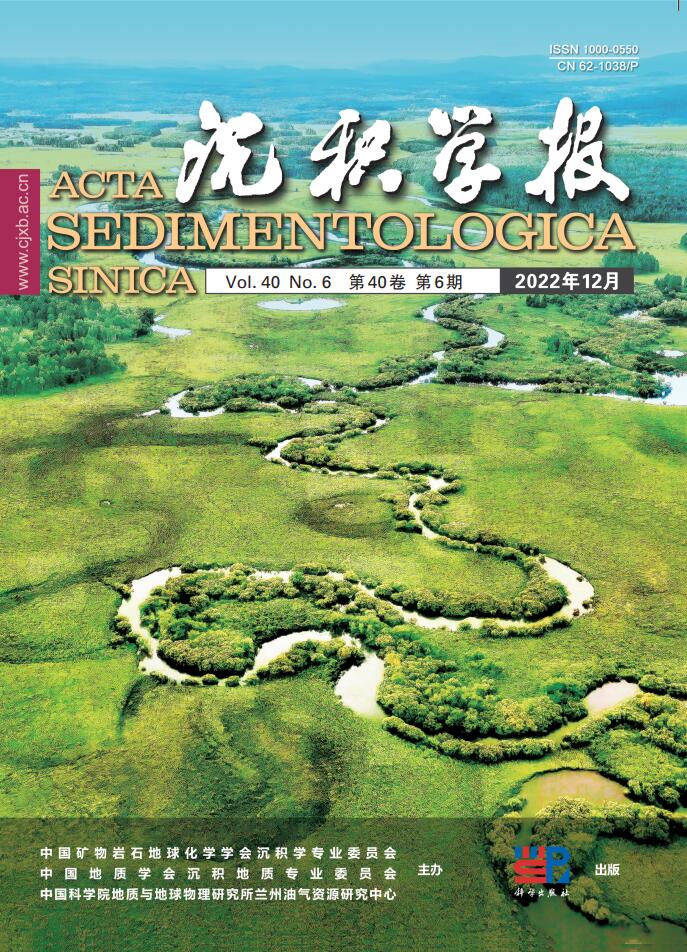


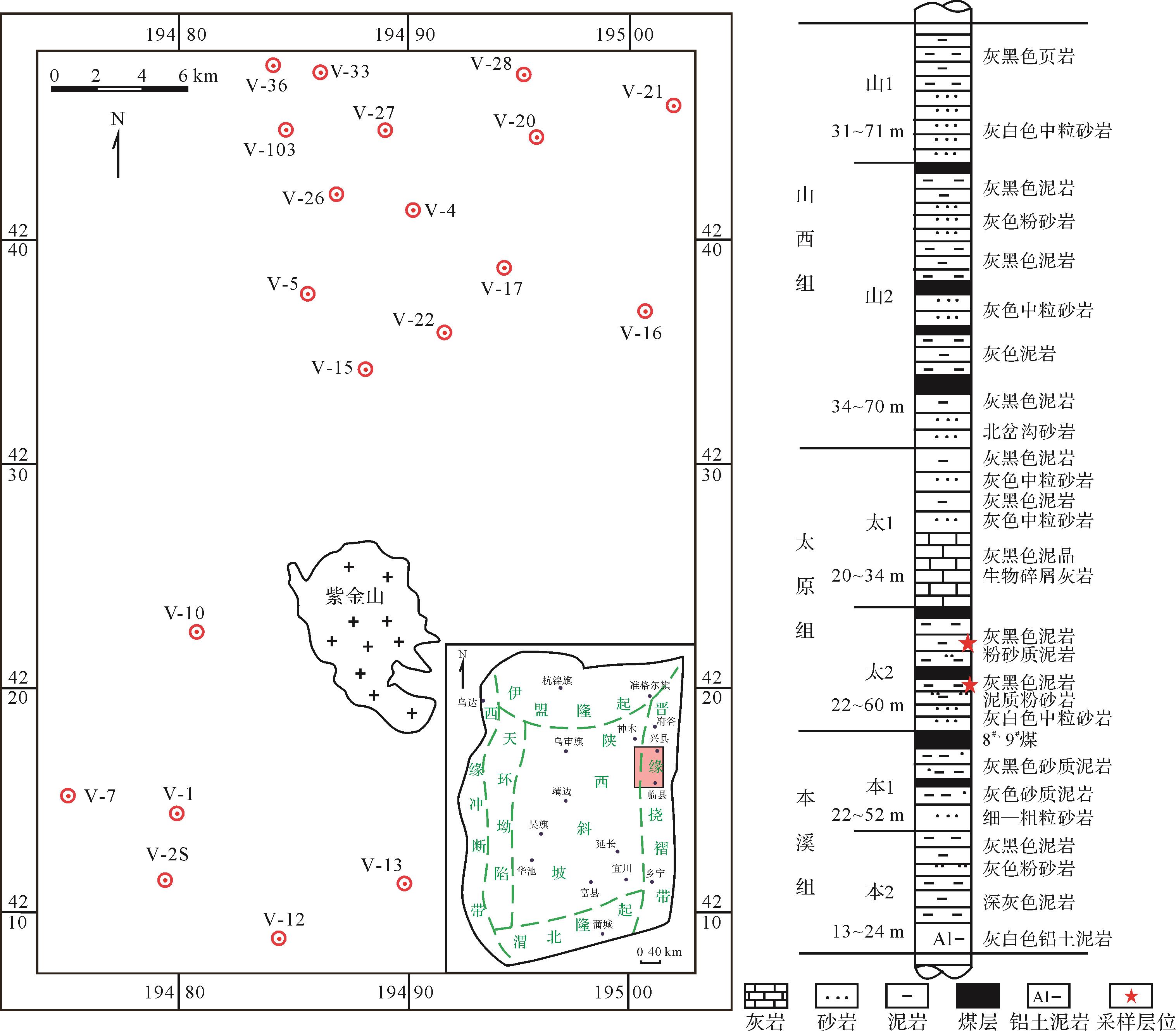










 DownLoad:
DownLoad:
